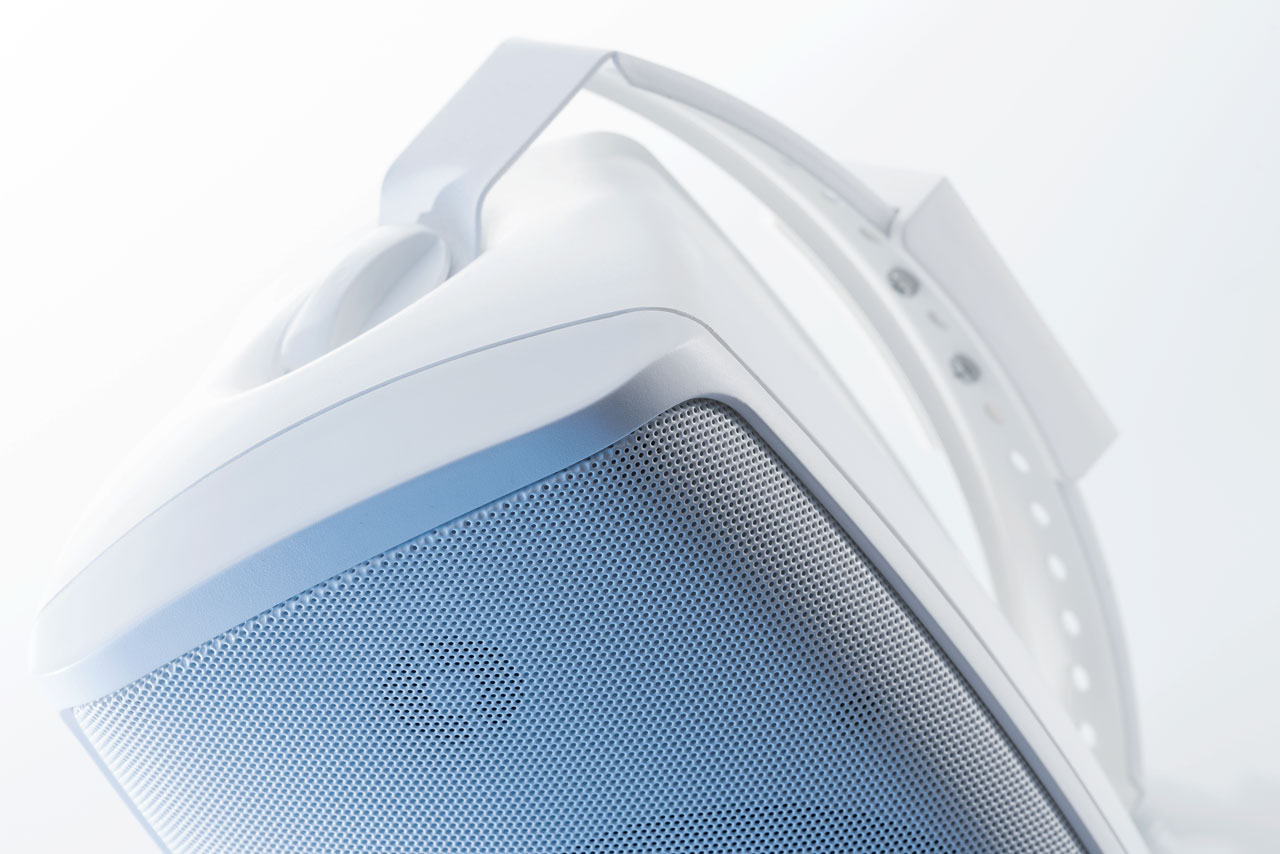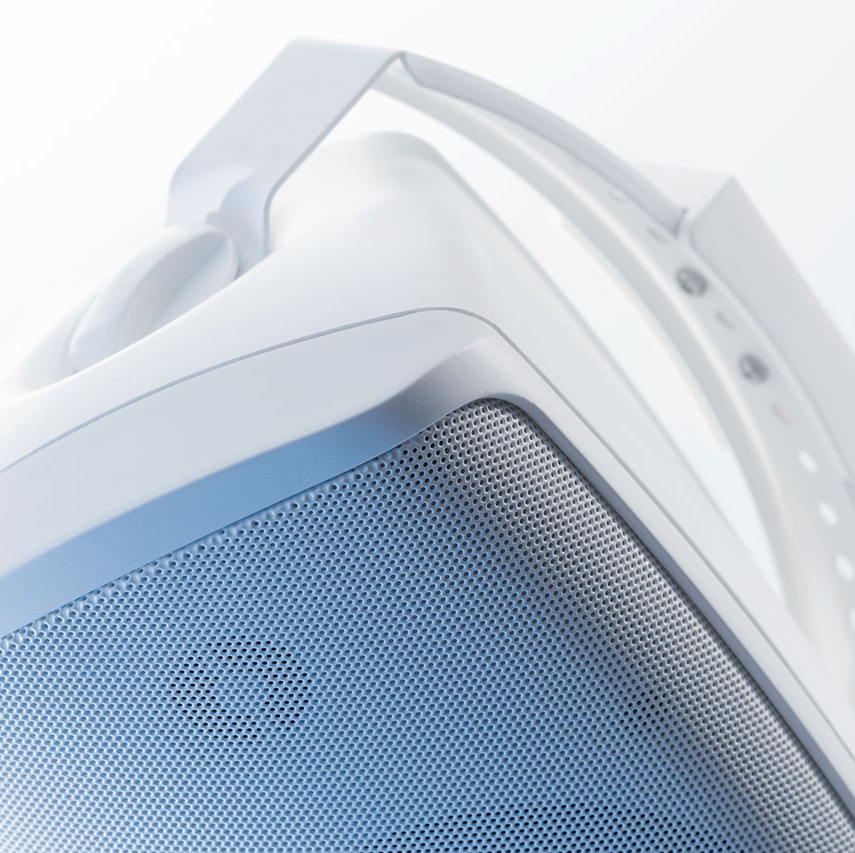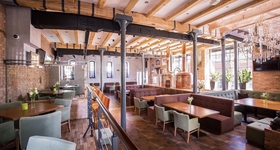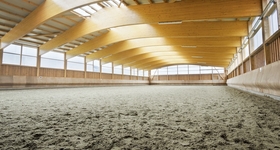
Wall Speakers: the Basics on Wall Speakers
How to position, align and select wall speakers: best practice scenarios and 9 general rules.
The most important rule for every PA installer and planner: not every speaker system sounds equally good in every situation. Thus, it is anything but trivial to plan PA systems. Our audio expert Michael Dreis knows what to consider when arranging wall speakers.
Positioning and Aligning Wall Speakers
Where exactly are the people standing or sitting during the PA application? The radiation angle of the speaker should be aligned accordingly.
This is particularly relevant because wall speakers are never positioned at eye level and thus never at ear level. Even though this would make sense acoustically, nobody does it. Nowadays, speakers are supposed to be positioned in an unobtrusive way. Thus, wall speakers should be suitable for pivoting and tilting. This will allow you to align them better if installed at a higher position in the room.
Rule 1: aim wall speakers directly at the recipients of your PA application and not just anywhere into the room
Avoid Phase Problems
However, the radiation direction of the wall speakers may present a particular problem:
If wall speakers radiate towards each other, phase problems may occur.
The frequencies of speakers with phase problems 'cannibalise' each other. This can be compared to waves in the water. Waves spread evenly. If two waves collide head-on, they cancel each other out. Imagine a stone falling into water: the waves spread out from the point of immersion. If you throw a second stone into the water at the same time or shortly afterwards, the waves disturb each other. The result would be chaos. This is similar to sound. Hence
Rule 2: every speaker in the room should, if possible, radiate into the same direction.
Positioning Wall Speakers in Small Rooms
If you are planning a PA application in rooms with less than 150 square metres, you should use fewer but more powerful speakers. Use a good PA amplifier and well-positioned, powerful wall speakers. Two to four speakers are often enough for a PA application with unidirectional radiation.
It is also possible to install the speakers in the corners of a room. This would emphasise low frequencies.
You can fully utilise this. If the bass range of a wall speaker is too flat for you, you can position it in the corner of the room to boost these frequencies. However, you should consider the stronger reflection in the corners of the room.
Rule 3: in smaller rooms, it is better to use fewer wall speakers with a moderate volume level and distribute them evenly across the wall.
Rule 4: wall speakers used for a PA application in a rather small room should preferably radiate from the long side into the room.
Positioning Wall Speakers in Large Rooms
If you use speakers for PA applications in bigger rooms and sales areas, the opposite rule applies: it is better to use more speakers for the same PA application. In this case, well-planned ceiling speakers may also be worthwhile. You can combine these with wall speakers and PA amplifiers.
Rule 5: complex PA applications benefit from a generous selection of evenly distributed wall and ceiling speakers with a lower volume level.
High operating range and maximum reliability: horn speakers
Lots of newcomers and non-experts find PA applications with horn speakers to be old school. However, this is no longer true because the new generation of horn speakers is often equipped with a 2-way system and thus provide a far better sound than the old railway station speakers. This does not mean that modern horn speakers are designed to become miracles of sound. However, today's horn speakers can provide a clear and distinct voice reproduction and a good music reproduction.
Nevertheless, the great strengths of horn speakers are still volume, reliability and the extensive operating range across open spaces.
Rule 6: Scenarios in which horn speakers can show their full potential include industrial halls, exhibition halls, multi-storey car parks, outdoor swimming pools, sports fields, leisure parks and railway stations.
We have prepared some best practice examples of application for horn speakers:
Column speakers: appealing appearance and precise directivity
Simply take the much-quoted phrase 'thinking outside the box' literally. Because the cube shape of traditional speaker systems sometimes just does not fit into the rooms and buildings. The alternative: slimline column speakers which are also known as line speakers or line array speakers. They adapt to the interior design of a building in a completely different way than traditional wall speaker systems. Especially for houses of worship, this is an advantage and easy to implement due to 100 V technology.
Low reflection, high directivity: different column speakers for a combined PA application
Column speakers are somewhat weaker in the low frequencies. Some column speakers feature such a slimline design that their cross-sectional area is hardly bigger than a 1 Euro coin. Thus, the speakers are almost invisible in the room. At the same time, the column and line design of the speakers allows for a vertically concentrated radiation and increases the operating range. Horizontally, it provides a wide radiation range. Reflections from the ceiling and from the floor are reduced due to the vertically concentrated radiation.
Line speakers and column speakers thus feature a wide, concentrated radiation.
A narrow exit angle easily allows a wider sound radiation into the room. Reflections are thus reduced. Imagine the beam of a flashlight in an environment that reflects light everywhere: With a more concentrated light beam, i.e. a smaller angle, you will have less reflections.
Together with the low weight and thus uncomplicated installation, column speakers and line array speakers in 100 V technology often provide an alternative to traditional speaker systems which is often underestimated.
Rule 7: column speakers are perfectly suitable for any scenario which requires an unobtrusive sound source.
Column speakers are able to cover numerous frequencies and are thus suitable for far more than just speech
At the same time, column speakers can also accommodate a vast amount of technology. This is because the sound engineer can stack up here without the speaker appearing to be chunky and thus dominating the room. The column speakers accommodate multiple bass speakers, midrange speakers and tweeters which work together. Therefore, it is possible to achieve a really improved sound reproduction. Column speakers provide a considerably high speech intelligibility which is important because otherwise lengthy speech transmissions may become difficult to listen to. For this purpose, sound engineers have worked extensively to achieve a fine and pleasant sound and a high sound quality.
Rule 8: If appearance and a great rich sound are to work together, you should apply column speakers at the front and add additional speaker systems in the back. Column speakers also fit into tight corners and wall recesses due to their slimline design.
When planning PA systems, please remember: reflections affect the sound experience. Although the angle of radiation is small, unwanted reflections occur much earlier with corner-mounted speakers than with column speakers distributed across the wall. It is beneficial to already discuss the installation of a PA system with architects and installers during the planning and building stage. The better you plan ahead, the better ...
1. the sound result.
2. the speakers can be integrated into the location.
Rule 9: column speakers are ideally suited for a flat installation on the wall. Please ensure that the column speakers can also be used for pivoting and tilting if installed near corners and ceilings.













